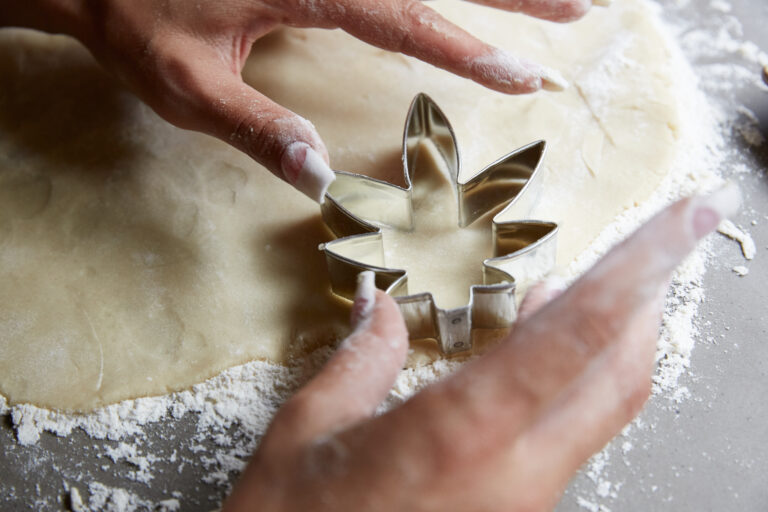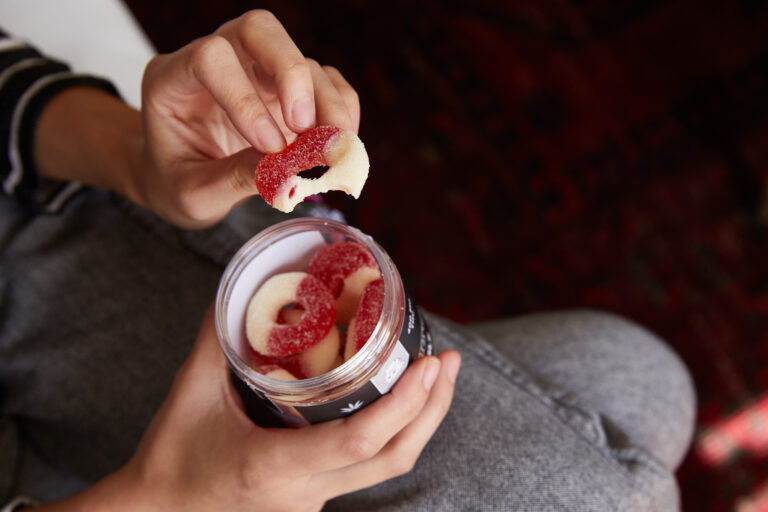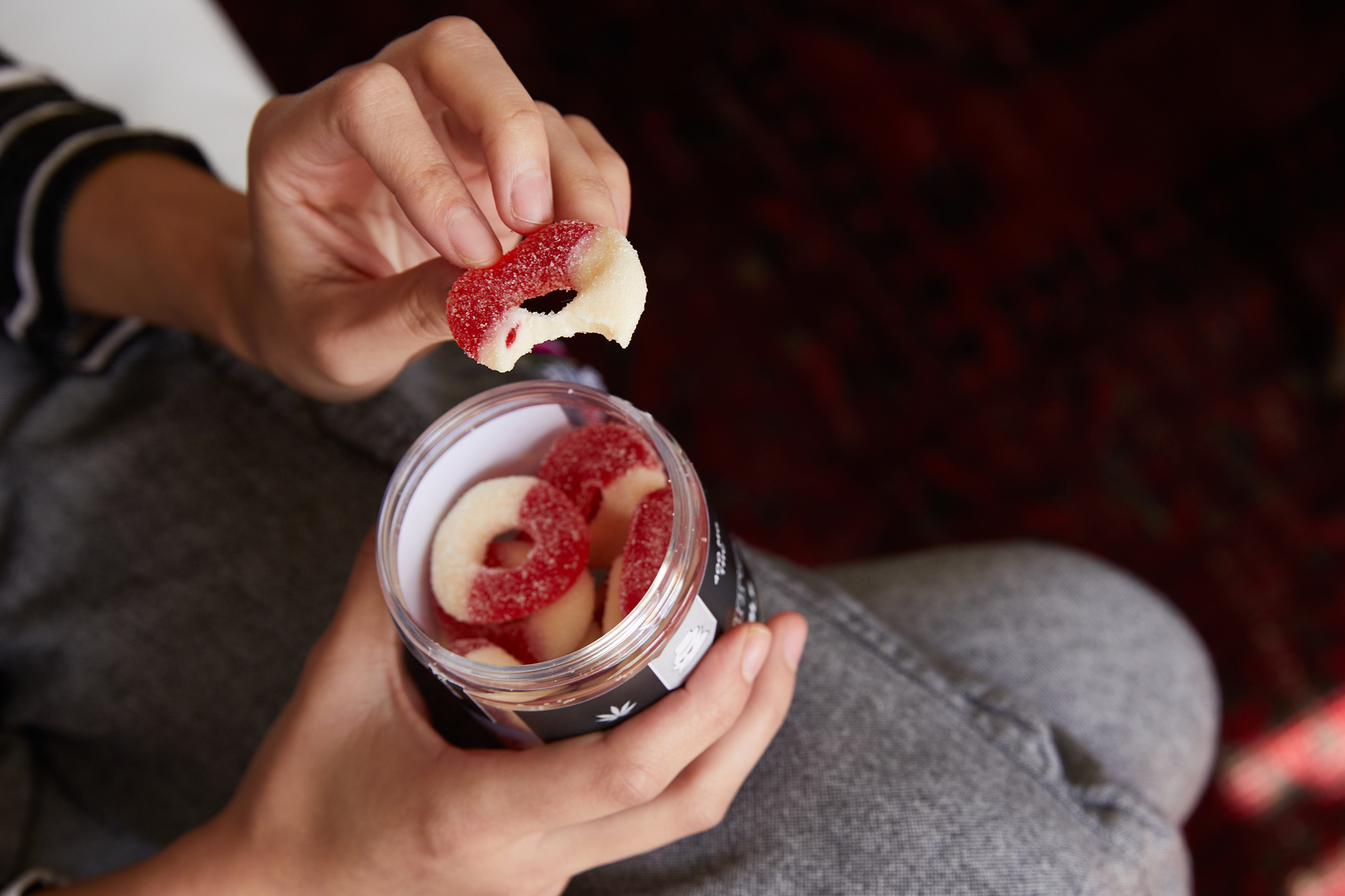Cannabis edibles can be almost anything your taste buds desire, from brownies to cookies, pasta, and more — any recipe that calls for butter or oil can be readily infused with cannabis. How did edibles get so popular? Where did they come from? Learn all about cannabis edibles, and try your hand at making your own.
History of edibles
The history behind THC edibles is a fascinating one. Historians have traced modern-day edibles back to 1500 BCE in India, where people prepared a beverage known as bhang by combining ground buds and leaves, ghee (clarified butter), and spices. As time went on, cannabis climbed in popularity across Europe, spurring the 15th-century Italian scholar Bartolomeo Platina to publish the very first cookbook, “On Honorable Pleasure and Health (1474),” which featured a cannabis edible recipe that read:
“To make cannabis yourself more commonly used as flax for thread, use a mallet to crush clods collected after a good harvest. Add cannabis to nard oil in an iron pot, crush together over some heat and liquefy into a health drink of cannabis nectar. Carefully treat food and divide for the stomach and the head. Finally, remember everything in excess may be harmful or criminal.
 Photo by: Gina Coleman/Weedmaps
Photo by: Gina Coleman/WeedmapsImage lightbox

Edibles remained part of cooking around the globe, but it took the legendary Alice B. Toklas, an expatriate living in Paris with her partner, Gertrude Stein, to prove that edibles did not need to be cooked to be enjoyed. Her friends, including Ernest Hemingway, Henri Matisse, and Pablo Picasso, were undoubtedly treated to her creations. Toklas' recipe achieved fame in the 1954 volume, The Alice B. Toklas Cookbook as “Haschich Fudge,” though it contains neither chocolate nor hash:
“Take 1 teaspoon black peppercorns, 1 whole nutmeg, 4 average sticks of cinnamon, 1 teaspoon coriander. These should all be pulverized in a mortar. About a handful each of de-stoned dates, dried figs, shelled almonds and peanuts: chop these and mix them together. A bunch of cannabis sativa can be pulverized. This along with the spices should be dusted over the mixed fruit and nuts, kneaded together. About a cup of sugar dissolved in a big pat of butter. Rolled into a cake and cut into pieces or made into balls about the size of a walnut, it should be eaten with care. Two pieces are quite sufficient.
The legend of Toklas ascended further with the 1968 film I Love You, Alice B. Toklas! starring Peter Sellers. The silver screen's portrayal of pot brownies immortalized them in cannabis cultures across the globe.
Brownie Mary's influence on medical cannabis
Mary Jane Rathbun, known as Brownie Mary, was a cannabis activist who had a huge influence on the legalization of medical cannabis through her compassionate care in the 1980s and 90s. At the height of the HIV/AIDS crisis in California, she made infused brownies for numerous patients and continued to advocate for medical cannabis legalization despite the multiple cannabis-related arrests she endured throughout her life.
Rathburn passed away in 1999, but her legacy lives on. Since 1992, August 25th has been declared “Brownie Mary Day” by the San Francisco Board of Supervisors to honor her and the work she did helping AIDS patients.
Cannabis edibles today
In today's cannabis culture, it's still very common for people to use weed to make their own edibles. But for those who live in a place where cannabis is legal, it's much more common to simply purchase edibles from a local dispensary, where a wide range of edible products and dosages can be found.
 Photo by: Gina Coleman/Weedmaps
Photo by: Gina Coleman/WeedmapsImage lightbox

The types of edibles at dispensaries include:
- Brownies
- Cookies
- Candy bars
- Gummies
- Mints
- Olive Oils
- Chips
- And much, much more.
Why choose edibles?
Edibles are enjoyed for a multitude of reasons, such as avoiding the inhalation of particulate matter or seeking a specific level of potency maintained over a longer period of time. Further benefits include:
- Precise dosage
- Control over ingredients
- Avoiding pollen and other plant particulate matter
- Discretion
- Longer-lasting effects
- People's ability to make their own recipes, so they know exactly what they're consuming
On the molecular level, eating cannabis can also mitigate your exposure to potentially damaging respiratory afflictions.
Edibles and the importance of decarboxylation
Decarboxylation is the most important step in preparing cannabis for consumption. Decarboxylation, or decarbing, alters THCA, releasing carbon dioxide and water, which ultimately converts THCA into intoxicating THC.
This process occurs naturally when flower ages, or more rapidly when it's cooked in oil or butter; it occurs instantaneously when cannabis is smoked. Cannabis used in capsules, topicals, and elixirs, among a host of other products, must be decarbed beforehand in order to convey its intoxicating or soothing effects.
 Photo by: Weedmaps
Photo by: WeedmapsImage lightbox

If you're wondering what happens if you eat weed that has not been decarboxylated, rest assured that it will not get you stoned; however, it's worth noting that raw cannabis, namely THCA, has demonstrated certain health benefits and is commonly used as a nutritional supplement and dietary enhancement.
Note: If you see THC on the edible's label, the effects will be intoxicating. If you see THCA, they will not be.
How are weed edibles digested?
Unlike inhalation, which causes THC to enter the bloodstream through the lungs, edibles enter the body through the mouth and are absorbed through the stomach for metabolization in the liver. The liver turns delta-9-THC into 11-hydroxy-THC, which is more potent than regular THC, has a longer half-life in the body, and can convey heavier sedative effects. This stronger form of THC is also particularly effective at crossing the blood-brain barrier, which is why you may feel more high from edibles than you ever will from inhaled cannabis.
What does an edibles high feel like?
Edibles are often associated with very intense highs. There are two key reasons for this:
- People eat more than they realize. Since edibles are processed through the digestive system, it takes longer for the effects to set in. Often, as people wait to feel something, they assume that they simply haven't eaten enough, and they continue to take more. By the time the effects finally hit them, they've consumed way too much and find themselves feeling much higher than they expected.
- Edibles take longer to metabolize. As a result, the effects produced by an edible last much longer than the effects produced by smoking or vaporizing cannabis. This extended time period helps create a much more intense experience than the faster-acting, shorter-lasting effects of smoking or vaping.
How to dose cannabis edibles
Dosing edibles correctly can require some trial and error due to their delayed onset and duration. Plus, weight, gender, age, genetics, and more can affect how your individual body metabolizes cannabinoids. Everyone is different. However, there are a few guidelines you can follow if you're new to cannabis edibles and need to get a feel for them first.
- Read the packaging to understand dosing information and familiarize yourself with the active ingredients. In many legal states, edibles packaging is required to display milligram dosages by serving to fully inform consumers of exactly how much they're ingesting.
- Avoid taking an edible on an empty stomach if it's you're first time consuming them. If you ingest an edible without eating beforehand, you may feel the effects much more quickly than if you consumed it on a full stomach.
The general rule for dosing is to start with a single dose of 1 to 5 milligrams of edible THC. You should then wait up to 2 to 4 hours to evaluate its effects before consuming more.
How long do edibles stay in your system?
Edible cannabinoids are processed differently than inhaled cannabinoids. When weed is ingested, cannabinoids enter the bloodstream through the stomach and liver, which increases potency and delays the onset of effects. This process also lengthens the intoxicating effects, sometimes causing them to last from four to six hours.
 Photo by: Gina Coleman/Weedmaps
Photo by: Gina Coleman/WeedmapsImage lightbox

Aside from the method of consumption, the amount of time that THC will remain in your system is contingent on several factors, including frequency of use and dosage, as well as individual-specific traits such as body mass, metabolism, and genetics. These various factors will play a role in how long the THC from an edible is detectable in the body.
FAQ
Where can you find edibles?
You can usually find THC-innfused edibles wherever cannabis is legally sold. Some CBD-infused products can be found in health-focused grocery stores. Edibles come in many forms, such as infused premade cookie dough or THC strips that melt on your tongue. In the world of cannabis edibles, the kitchen is your oyster.
How do you make cannabutter at home?
Since cannabinoids are fat-soluble, cooking them in a fatty substance allows for easy inclusion in a multitude of dishes, including baked goods, sauces, and candy. One of the simplest methods of creating a cannabis edible is by way of cannabutter, which can be used in almost any recipe.
 Photo by: Gina Coleman/Weedmaps
Photo by: Gina Coleman/WeedmapsImage lightbox

Here's what you'll need:
- Slow cooker
- Rubber spatula
- Fine-mesh strainer
- Glass jars
Ingredients
- ½ lb. butter
- ½ ounce decarbed cannabis
Steps
- Set the slow cooker on the lowest setting and add the butter
- Stir until it has coated the bottom and some of the sides of the slow cooker to protect your flower from charring
- Once the butter has completely melted, pour the cannabis into the center and stir gently
- Allow the butter and cannabis to simmer for 1 hour, but keep an eye on the mixture and stir it every 20 minutes to ensure even cooking
- When finished cooking, pour the mixture through a fine-mesh strainer into a glass jar
- Place jar in the refrigerator and allow it to chill overnight
- Use within two months if stored in the fridge or six months if stored in the freezer.
Featured image by Gina Coleman/Weedmaps




